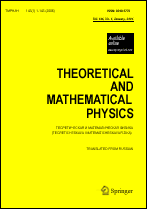|
This article is cited in 26 scientific papers (total in 26 papers)
A Weyl–Cartan space–time model based on the gauge principle
O. V. Babourovaa, V. Ch. Zhukovskiib, B. N. Frolova
a Moscow State Pedagogical University
b M. V. Lomonosov Moscow State University
Abstract:
Based on the requirement that the gauge invariance principle for
the Poincaré–Weyl group be satisfied for the space–time manifold, we
construct a model of space–time with the geometric structure of
a Weyl–Cartan space. We show that three types of fields must then be
introduced as the gauge (“compensating”) fields: Lorentz,
translational, and dilatational. Tetrad coefficients then become functions of
these gauge fields. We propose a geometric interpretation of the Dirac scalar
field. We obtain general equations for the gauge fields, whose sources can be
the energy–momentum tensor, the total momentum, and the total dilatation
current of an external field. We consider the example of a direct coupling of
the gauge field to the orbital momentum of the spinor field. We propose
a gravitational field Lagrangian with gauge-invariant transformations of
the Poincaré–Weyl group.
Keywords:
gauge field, Poincaré–Weyl group, Noether theorem, Weyl–Cartan space, dilatation current.
Received: 15.11.2007
Revised: 25.01.2008
Citation:
O. V. Babourova, V. Ch. Zhukovskii, B. N. Frolov, “A Weyl–Cartan space–time model based on the gauge principle”, TMF, 157:1 (2008), 64–78; Theoret. and Math. Phys., 157:1 (2008), 1420–1432
Linking options:
https://www.mathnet.ru/eng/tmf6264https://doi.org/10.4213/tmf6264 https://www.mathnet.ru/eng/tmf/v157/i1/p64
|


| Statistics & downloads: |
| Abstract page: | 1233 | | Full-text PDF : | 460 | | References: | 113 | | First page: | 16 |
|




 Contact us:
Contact us: Terms of Use
Terms of Use
 Registration to the website
Registration to the website Logotypes
Logotypes








 Citation in format
Citation in format 
